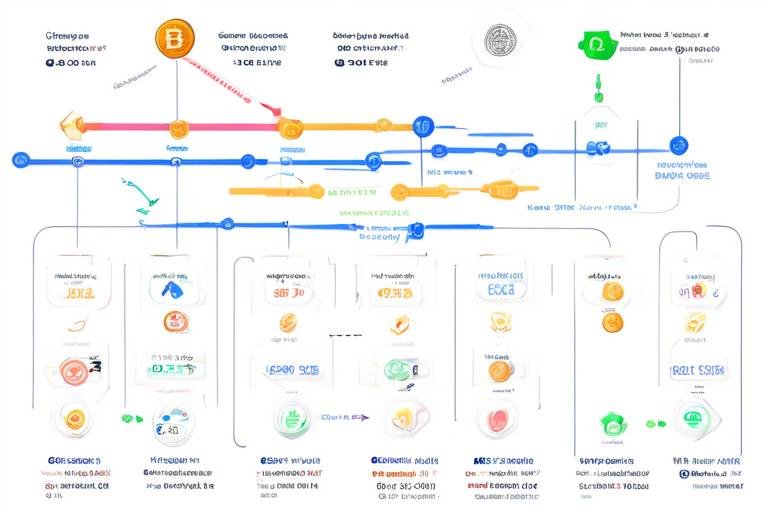The Importance of Real-Time Market Analysis in Trading
In the fast-paced world of trading, where every second counts, real-time market analysis has emerged as a game-changer for traders seeking to maximize their profits and minimize their risks. Imagine standing at the edge of a bustling marketplace, where every whisper and movement can signal a potential opportunity or threat. This is the essence of real-time market analysis—it's about being in the right place at the right time, equipped with the most current information to make informed decisions.
Real-time market analysis involves the continuous monitoring of market data as it happens. This means traders have access to the latest trends, price movements, and market sentiments, allowing them to react swiftly to changes. Think of it as having a radar that detects incoming opportunities and potential pitfalls before they become apparent to others. In this article, we will explore the significance of real-time market analysis and how it contributes to better decision-making, effective risk management, and ultimately, trading success.
At its core, real-time market analysis is about leveraging up-to-the-minute data to inform trading strategies. Unlike traditional analysis, which may rely on historical data and trends, real-time analysis keeps traders in the loop with what’s happening right now. This immediacy is crucial, especially in volatile markets where prices can fluctuate dramatically within minutes. By understanding the current market dynamics, traders can make decisions that are not only timely but also relevant to the current economic landscape.
Access to real-time market data is akin to having a backstage pass to the financial world. It provides traders with immediate insights, enabling them to capitalize on potential opportunities that others might miss. Here are some key benefits of utilizing real-time market data:
- Improved Decision-Making: Real-time analysis enhances decision-making by providing traders with the latest information, reducing the reliance on outdated data. This shift increases the likelihood of successful trades, as traders can act based on the most current market conditions.
- Accuracy in Predictions: Utilizing real-time data significantly improves the accuracy of market predictions. Traders can identify trends and shifts before they fully materialize, allowing them to position themselves advantageously.
- Increased Market Responsiveness: With access to real-time information, traders can respond to market fluctuations more effectively. This leads to better trade execution and timing, which are critical for maximizing profits.
Effective risk management is a cornerstone of successful trading. In a landscape where risks are ever-present, real-time market analysis acts as a safety net, helping traders identify potential risks and adjust their strategies accordingly. By continuously monitoring market conditions, traders can spot warning signs and take proactive measures to mitigate losses.
To harness the power of real-time market analysis, traders have access to a variety of tools and platforms designed to enhance their trading strategies. Each tool offers unique features that cater to different trading styles:
Advanced trading software provides real-time data visualization, allowing traders to analyze market conditions and execute trades efficiently. These platforms often include features such as:
- Live charts and graphs
- Customizable dashboards
- Automated trading options
Staying updated with market news feeds ensures that traders are aware of events that could impact their trading decisions. This information provides essential context to real-time data and helps traders understand the broader economic landscape. For example, a sudden political event or economic report can shift market sentiment dramatically, and having access to this news in real-time allows traders to adjust their strategies accordingly.
Q1: How does real-time market analysis improve trading outcomes?
Real-time market analysis improves trading outcomes by providing traders with the most current data, enabling them to make informed decisions quickly and accurately. This leads to better timing in entering and exiting trades, ultimately enhancing profitability.
Q2: What tools are best for real-time market analysis?
The best tools for real-time market analysis include advanced trading software that offers data visualization, market news feeds for timely updates, and analytical tools that help traders interpret trends and patterns effectively.
Q3: Can beginners benefit from real-time market analysis?
Absolutely! Beginners can greatly benefit from real-time market analysis as it provides them with insights that can help them learn and make informed decisions. Using the right tools and resources, even novice traders can navigate the market more effectively.

Understanding Real-Time Market Analysis
Real-time market analysis is the cornerstone of modern trading strategies. Imagine standing at the edge of a bustling marketplace, where every second counts and the dynamics shift rapidly. This is exactly how traders operate in the financial markets. Real-time market analysis involves the continuous monitoring of market data as it unfolds, allowing traders to make informed decisions based on the latest trends and information. Instead of relying on historical data that may no longer be relevant, traders who utilize real-time analysis can react to market movements as they happen, creating a significant edge over those who don’t.
At its core, real-time market analysis is about timeliness and accuracy. It encompasses various data points, including price movements, trading volume, and market sentiment. By keeping a finger on the pulse of the market, traders can identify opportunities that might otherwise go unnoticed. For instance, a sudden spike in trading volume could indicate an impending price movement, and being aware of this in real-time can lead to profitable trades.
Furthermore, real-time market analysis is not just about reacting; it’s also about anticipating. Traders equipped with up-to-the-minute data can spot emerging trends and shifts before they fully materialize. This proactive approach can be likened to a surfer catching the perfect wave; the key is to be in the right place at the right time. With the right tools and insights, traders can position themselves advantageously, maximizing their potential for success.
In addition to market data, real-time analysis often incorporates news feeds and social media sentiment. Events like economic reports, geopolitical developments, or corporate earnings announcements can have immediate effects on market prices. By integrating these elements into their analysis, traders can gain a more holistic view of the market landscape. For example, a trader might notice that a positive earnings report is accompanied by a surge in social media chatter. This combination of factors can reinforce the decision to enter a trade.
Ultimately, understanding real-time market analysis is about more than just data; it’s about developing a keen sense of awareness and adaptability. The financial markets are inherently volatile, and the ability to pivot quickly in response to new information can make all the difference between a successful trade and a costly mistake. As we delve deeper into the benefits of real-time market data, it becomes clear that this approach is not merely advantageous—it is essential for anyone looking to thrive in today’s fast-paced trading environment.

Benefits of Real-Time Market Data
Access to real-time market data is like having a superpower in the world of trading. Imagine being able to see the market as it unfolds, catching every twist and turn before anyone else. This immediacy allows traders to make decisions based on the latest information, rather than relying on outdated data that could lead to missed opportunities or, worse, costly mistakes. By leveraging real-time data, traders can react swiftly to market changes, ensuring they stay ahead of the curve.
One of the primary benefits of real-time market data is the enhancement of decision-making. When traders have access to the most current information, they can analyze trends and shifts with greater accuracy. This means they can spot potential opportunities that others might overlook. For instance, if a stock suddenly spikes in value due to breaking news, a trader with real-time data can jump on that opportunity immediately, potentially reaping significant rewards.
Moreover, real-time data improves the accuracy of predictions. By utilizing up-to-the-minute information, traders can identify trends and shifts before they fully materialize. This predictive capability is crucial in a market that can change in an instant. For example, if a trader notices a pattern emerging in a particular stock's price movements, they can act quickly to capitalize on it, rather than waiting for confirmation that might come too late.
Another vital aspect of real-time market data is increased market responsiveness. Traders equipped with live data can respond to market fluctuations more effectively. This real-time responsiveness leads to better trade execution and timing, which are essential for maximizing profits. For instance, if a trader sees a sudden drop in a stock's price, they can decide whether to sell, hold, or even buy more shares based on the latest data, rather than relying on stale information that may no longer be relevant.
To illustrate the impact of real-time data on trading decisions, consider the following table that compares trading outcomes with and without real-time market data:
| Scenario | With Real-Time Data | Without Real-Time Data |
|---|---|---|
| Market Spike | Immediate buy action, capturing profits | Missed opportunity, delayed reaction |
| Market Drop | Quick sell to minimize losses | Hold until losses increase |
| Trend Identification | Early entry into a rising stock | Late entry, reduced profit potential |
In conclusion, the benefits of real-time market data cannot be overstated. It empowers traders to make informed decisions, enhances the accuracy of their predictions, and increases their responsiveness to market changes. In a fast-paced trading environment, having access to real-time data is not just an advantage; it is a necessity for anyone serious about achieving success in the market.
- What is real-time market data? - Real-time market data refers to the most current information regarding asset prices, trading volumes, and market conditions as they happen.
- How can I access real-time market data? - You can access real-time market data through various trading platforms, financial news websites, and specialized market analysis tools.
- Why is real-time data important for traders? - Real-time data is crucial because it allows traders to make informed decisions quickly, helping them to capitalize on market movements and manage risks effectively.
- Are there any tools available for real-time market analysis? - Yes, there are many tools available, including advanced trading software and market news feeds that provide live updates and insights.

Improved Decision-Making
When it comes to trading, decision-making is everything. Imagine standing at a crossroads, where each path represents a different trading opportunity. Without real-time market analysis, you might find yourself relying on outdated maps that don’t reflect the current landscape. This is where real-time data comes into play, acting as your compass, guiding you towards the most profitable paths.
Real-time market analysis provides traders with the most up-to-date information available. This immediacy is crucial because the market is a living entity; it changes rapidly, often in the blink of an eye. By having access to live data, traders can make decisions based on the latest trends and fluctuations, rather than relying on information that may be hours or even days old. For instance, if a trader notices a sudden spike in stock prices due to breaking news, they can act swiftly to either capitalize on the surge or mitigate potential losses.
Moreover, real-time data reduces the emotional burden of trading. Traders often face pressure when making decisions, and the fear of missing out (FOMO) can lead to hasty choices. With real-time analysis, traders can feel more confident in their decisions, knowing they are based on current data rather than speculation. This confidence can be the difference between a successful trade and a costly mistake.
To illustrate, let’s consider a scenario where a trader is monitoring the stock of a tech company. Thanks to real-time market analysis tools, they observe a sudden increase in trading volume, indicating heightened interest. Coupled with news of a product launch, this trader can make an informed decision to buy shares before the price potentially skyrockets. On the other hand, if they were relying on outdated data, they might miss out on this golden opportunity.
In addition, real-time market analysis enhances the ability to identify patterns and trends that may not be visible through historical data alone. For example, by analyzing live charts and indicators, traders can spot emerging trends and adjust their strategies accordingly. This adaptability is crucial in a market that is constantly evolving.
In summary, improved decision-making through real-time market analysis is not just a luxury; it’s a necessity for today’s traders. It equips them with the tools to make informed choices, react to market changes swiftly, and ultimately increases their chances of success in the trading arena. As the saying goes, “Time is money,” and in trading, every second counts.
- What is real-time market analysis?
Real-time market analysis involves monitoring market data as it happens, allowing traders to make informed decisions based on the latest trends and information. - How does real-time data improve decision-making?
It provides traders with up-to-date information, reducing reliance on outdated data and increasing the likelihood of successful trades. - What tools are available for real-time market analysis?
There are various tools, including advanced trading software and market news feeds, that assist traders in conducting real-time market analysis.

Accuracy in Predictions
When it comes to trading, the ability to make accurate predictions can be the difference between profit and loss. Real-time market analysis plays a pivotal role in enhancing this accuracy. By constantly monitoring market data as it unfolds, traders can identify emerging trends and shifts before they fully materialize. Imagine standing at the edge of a bustling market, where every second counts. Just like a hawk that spots its prey from afar, a trader equipped with real-time data can seize opportunities that others might miss.
One of the key advantages of real-time analysis is the reduction of lag time between data collection and decision-making. Traditional methods often rely on historical data, which can be outdated by the time a trader acts on it. In contrast, real-time data provides a live feed of market conditions, allowing traders to make informed decisions based on the latest information. This immediacy is crucial, especially in volatile markets where conditions can change rapidly.
Moreover, the accuracy of predictions is significantly enhanced when traders can correlate real-time data with various market indicators. For instance, when analyzing price movements, traders can look at volume changes, order book depth, and other technical indicators simultaneously. This multi-faceted approach enables them to form a comprehensive view of the market landscape, leading to more precise predictions. Traders can also utilize advanced algorithms and machine learning models that process real-time data to forecast future price movements with greater reliability.
To illustrate the impact of accuracy in predictions, consider the following table that compares traditional analysis methods with real-time analysis:
| Aspect | Traditional Analysis | Real-Time Analysis |
|---|---|---|
| Data Source | Historical data | Live market data |
| Speed of Decision | Slower, due to data lag | Instantaneous |
| Prediction Accuracy | Variable | Higher, due to current insights |
| Market Responsiveness | Low | High |
In summary, the accuracy of predictions in trading is greatly enhanced through the use of real-time market analysis. By having access to the latest data, traders can respond to market changes with agility and precision. This not only boosts their confidence in making trades but also significantly increases their chances of success. As the saying goes, "knowledge is power," and in the fast-paced world of trading, being armed with real-time insights is like having a superpower.
- What is real-time market analysis? - It involves monitoring market data as it happens, allowing traders to make informed decisions based on the latest trends.
- How does real-time data improve trading accuracy? - It reduces reliance on outdated information and enables traders to identify trends and shifts in the market as they occur.
- What tools are used for real-time market analysis? - Traders often use advanced trading software and market news feeds to stay updated on market conditions.
- Why is risk management important in trading? - Effective risk management helps traders identify potential risks and adjust their strategies accordingly to minimize losses.

Increased Market Responsiveness
In the fast-paced world of trading, market responsiveness can be the difference between a profitable trade and a missed opportunity. When traders have access to real-time market analysis, they can react to fluctuations almost instantaneously. Imagine being at a concert where the band suddenly plays your favorite song; you wouldn't want to be caught off guard, right? Similarly, in trading, you want to be ready to seize opportunities the moment they arise.
Real-time data allows traders to monitor price changes, volume shifts, and market sentiment as they happen. This immediate access to information means that traders can adjust their strategies on the fly. For example, if a stock suddenly spikes due to positive news, a trader with real-time data can quickly decide to buy before the price climbs even higher. On the flip side, if they see signs of a downturn, they can sell before losses accumulate.
Moreover, the ability to respond quickly is not just about reacting to price changes. It also involves understanding the context behind those changes. For instance, a sudden drop in stock prices might be due to a broader market trend or a specific event affecting a company. Traders who stay informed through real-time market analysis can interpret these signals better, allowing them to make more informed decisions. This is akin to being a detective; the more clues you have, the clearer the picture becomes.
To illustrate the importance of increased market responsiveness, consider the following table, which outlines the benefits of real-time analysis compared to traditional methods:
| Aspect | Real-Time Analysis | Traditional Analysis |
|---|---|---|
| Speed of Information | Immediate | Delayed |
| Decision-Making | Informed and timely | Often reactive |
| Market Sentiment | Current | Historical |
| Risk Management | Proactive | Reactive |
In conclusion, increased market responsiveness through real-time analysis empowers traders to navigate the complexities of the market with confidence. By staying updated and being able to act swiftly, traders can not only protect their investments but also maximize their potential returns. So, the next time you think about your trading strategy, remember that staying responsive is not just an advantage; it's a necessity in today's trading environment.
- What is real-time market analysis? Real-time market analysis involves monitoring live market data to make informed trading decisions based on the latest trends.
- How does real-time data improve trading decisions? It provides traders with up-to-date information, allowing them to react quickly to market changes and make better-informed decisions.
- What tools can I use for real-time market analysis? Various tools, including advanced trading software and market news feeds, can help traders access real-time data effectively.

Risk Management Strategies
In the fast-paced world of trading, having a solid risk management strategy is not just beneficial; it's essential. Think of it as your safety net while you navigate the thrilling yet unpredictable market landscape. Without a well-defined strategy, traders can easily fall into the trap of emotional decision-making, leading to costly mistakes. So, what does effective risk management look like? It involves a combination of techniques aimed at minimizing potential losses while maximizing gains.
One of the foundational aspects of risk management is the concept of position sizing. This refers to determining how much capital to allocate to a particular trade based on your overall portfolio size and risk tolerance. For instance, if you have a $10,000 trading account and you decide to risk 1% on a trade, you would only risk $100. This approach helps you survive the inevitable losing streaks that every trader faces. By limiting your exposure per trade, you ensure that a few losses won’t wipe out your entire account.
Another critical strategy is the use of stop-loss orders. A stop-loss order is a predetermined price at which you will exit a losing trade to prevent further losses. Imagine you're on a roller coaster; you wouldn't want to go off the rails, right? Stop-loss orders act as your safety harness, keeping you secure even when the market takes a sudden plunge. By setting these orders, you can protect your capital and maintain a disciplined approach to trading.
Moreover, diversification plays a crucial role in risk management. Instead of putting all your eggs in one basket, consider spreading your investments across various assets. This way, if one investment underperforms, others may offset the losses. Picture a well-balanced meal; it’s not just about one ingredient but a mix that provides overall nourishment. Similarly, a diversified portfolio can help stabilize your returns and reduce volatility.
Lastly, it's vital to continuously monitor and adjust your strategies based on real-time market analysis. The market is ever-changing, and what worked yesterday might not work today. By staying informed and flexible, you can adapt your risk management strategies to current market conditions. This proactive approach ensures that you remain one step ahead, ready to seize opportunities while mitigating risks.
In summary, effective risk management strategies are the backbone of successful trading. By employing techniques such as position sizing, stop-loss orders, diversification, and ongoing market analysis, traders can significantly reduce their exposure to risks. Remember, trading without a plan is like sailing without a compass; you might get somewhere, but it’s unlikely to be where you want to go.
- What is risk management in trading? Risk management in trading refers to the strategies and techniques used to minimize potential losses and protect capital while maximizing potential gains.
- Why is position sizing important? Position sizing helps determine how much of your capital to risk on a single trade, ensuring that you do not overexpose yourself to losses.
- How do stop-loss orders work? Stop-loss orders are pre-set orders that automatically sell an asset when it reaches a certain price, helping to limit potential losses.
- What is diversification and why is it necessary? Diversification involves spreading your investments across different assets to reduce risk. It helps mitigate the impact of a poor-performing investment on your overall portfolio.
- How can I adjust my risk management strategies? Regularly review your trading performance, stay informed about market conditions, and be ready to adapt your strategies as necessary.

Tools for Real-Time Market Analysis
In the fast-paced world of trading, having the right tools at your disposal is absolutely essential for success. Think of real-time market analysis tools as your trusted companions on a thrilling adventure through the financial landscape. They provide you with the insights and information you need to navigate the twists and turns of market fluctuations. With a plethora of options available, it can be overwhelming to choose the right tools that align with your trading strategy. However, understanding the various tools and their functionalities can significantly enhance your trading experience.
One of the most vital tools for real-time market analysis is trading software. This software is designed to provide traders with real-time data visualization, enabling them to analyze market conditions efficiently. Imagine you’re in a race car, and your trading software is the dashboard that gives you all the vital stats you need at a glance. You can monitor speed, fuel levels, and even the road conditions ahead. Similarly, trading software allows you to track price movements, volume, and market trends in real-time, ensuring that you are always one step ahead of the competition.
Additionally, market news feeds play a crucial role in real-time market analysis. These feeds deliver up-to-the-minute news and events that could impact the markets. Picture yourself as a detective, piecing together clues to solve a mystery. Market news feeds provide context to the real-time data you’re analyzing, helping you understand the “why” behind the price movements. Whether it’s economic reports, geopolitical events, or corporate announcements, staying updated with market news feeds ensures that you are well-informed and can make educated trading decisions.
Moreover, many traders benefit from using charting tools that allow them to visualize market trends over different time frames. These tools can help identify patterns that may not be immediately obvious from raw data. For example, a candlestick chart can reveal whether a stock is in a bullish or bearish trend, guiding traders in their decision-making process. The ability to interpret these charts effectively can be the difference between a successful trade and a missed opportunity.
Furthermore, algorithmic trading platforms have gained popularity among traders who prefer automated strategies. These platforms utilize complex algorithms to analyze market data and execute trades based on pre-defined criteria. Imagine having a highly skilled assistant who works tirelessly, analyzing data and executing trades even while you sleep. This can free up your time and allow you to focus on other aspects of your trading strategy.
In summary, the right tools for real-time market analysis can significantly enhance your trading capabilities. By leveraging advanced trading software, market news feeds, charting tools, and algorithmic trading platforms, you can equip yourself with the knowledge and insights needed to thrive in the dynamic world of trading. As you explore these tools, remember that the key is to find the ones that resonate with your trading style and objectives.
- What is real-time market analysis? Real-time market analysis involves monitoring current market data to make informed trading decisions based on the latest trends and information.
- Why is real-time data important in trading? Access to real-time data allows traders to react swiftly to market changes, improving decision-making and increasing the likelihood of successful trades.
- What tools are best for real-time market analysis? Some of the best tools include trading software, market news feeds, charting tools, and algorithmic trading platforms.
- How can I improve my trading strategy? By utilizing real-time market analysis tools, you can enhance your decision-making process, manage risks effectively, and capitalize on trading opportunities.

Trading Software
In the fast-paced world of trading, having the right tools can make all the difference between success and failure. serves as the backbone for many traders, providing them with the necessary resources to analyze market conditions, execute trades, and manage their portfolios effectively. Think of it as your personal trading assistant, always ready to offer insights and keep you informed about the latest market movements. The beauty of trading software lies in its ability to present complex data in a user-friendly format, allowing traders to make quick decisions without getting lost in a sea of numbers.
One of the primary advantages of using advanced trading software is its capability to visualize real-time data. This means that you can see price movements, volume changes, and other critical indicators as they happen. For instance, imagine you're watching a thrilling sports game; the excitement builds as the score changes with each play. Similarly, trading software keeps you on the edge of your seat, providing you with live updates that can influence your trading strategy. This immediacy allows traders to react promptly to market fluctuations, ensuring they don't miss out on potential profits.
Moreover, many trading platforms come equipped with a variety of analytical tools that help traders identify trends and patterns. These features can include:
- Charting tools that display price movements over different time frames
- Indicators such as moving averages, RSI, and MACD that assist in forecasting future market behavior
- Backtesting capabilities that allow traders to test their strategies against historical data
With these tools at their disposal, traders can enhance their decision-making process, leading to more informed and confident trading actions.
Additionally, trading software often integrates with market news feeds, providing a comprehensive view of the market landscape. This integration is crucial, as it allows traders to stay updated on economic events, earnings reports, and geopolitical developments that could impact their trades. For example, if a major economic report is released, traders can quickly assess how it might affect their positions and adjust their strategies accordingly. By combining real-time data with relevant news, traders can make decisions that are not only timely but also contextually informed.
As technology continues to evolve, so does trading software. Many platforms now offer mobile applications, enabling traders to monitor their investments and execute trades from anywhere in the world. This flexibility is akin to having a trading desk in your pocket, allowing you to seize opportunities even when you're on the go. Imagine being able to react to market changes while enjoying a coffee at your favorite café; that's the power of modern trading software!
In conclusion, the importance of trading software in the realm of real-time market analysis cannot be overstated. It empowers traders by providing them with the tools they need to make swift, informed decisions. As you explore various trading platforms, consider what features are most important to you and how they align with your trading style. After all, in the world of trading, having the right software can be the difference between merely participating and truly thriving.
Q: What features should I look for in trading software?
A: Look for software that offers real-time data visualization, analytical tools, customizable charts, and integration with market news feeds. These features will enhance your trading experience and decision-making capabilities.
Q: Can I use trading software on my mobile device?
A: Yes, many trading platforms now offer mobile applications that allow you to monitor your trades and market conditions from anywhere.
Q: How does trading software help with risk management?
A: Trading software provides tools for setting stop-loss orders and alerts, which can help you manage your risk by automatically executing trades based on your predefined criteria.

Market News Feeds
In the fast-paced world of trading, staying informed is not just an advantage; it’s a necessity. serve as the lifeline for traders, providing real-time updates on economic events, geopolitical developments, and market sentiment. Imagine trying to navigate a stormy sea without a compass; that’s what trading without timely news feels like. Traders who are plugged into reliable news feeds can swiftly adjust their strategies based on the latest information, ensuring they remain at the forefront of market movements.
These feeds deliver a continuous stream of information, including economic indicators, earnings reports, and central bank announcements. For instance, a sudden interest rate change by a central bank can send shockwaves through the market, affecting currency values and stock prices almost instantly. By having access to these updates, traders can make informed decisions, whether they are day trading or holding positions for the long term.
Furthermore, many traders utilize a combination of automated alerts and curated news sources to stay ahead of the curve. Here’s how you can leverage market news feeds effectively:
- Choose Reliable Sources: Not all news is created equal. Opt for established financial news outlets and platforms that provide timely and accurate information.
- Set Up Alerts: Use tools that allow you to set up alerts for specific events or market movements. This way, you won’t miss crucial updates.
- Integrate with Trading Platforms: Many advanced trading platforms offer integrated news feeds, allowing you to view market data and news concurrently.
Moreover, the impact of news on market trends can be profound. For example, a positive earnings report from a major tech company can lead to a surge in stock prices, while negative news regarding regulatory changes can trigger sell-offs. Understanding how to interpret these news feeds can provide traders with a significant edge. It’s akin to having a backstage pass to the concert of market dynamics, where you can anticipate the hits before they play out.
In conclusion, are indispensable tools for traders aiming to navigate the complexities of financial markets. By staying updated with real-time information, traders can not only enhance their decision-making but also improve their overall trading performance. In a world where information is power, being connected to the pulse of the market can make all the difference.
Q1: What are market news feeds?
Market news feeds are real-time updates that provide traders with information on economic events, market sentiment, and other news that can impact trading decisions.
Q2: How can I access market news feeds?
You can access market news feeds through various financial news websites, trading platforms, and dedicated news aggregator apps that offer real-time updates.
Q3: Why are market news feeds important for traders?
They are crucial because they provide timely information that can affect market movements, allowing traders to make informed decisions and adjust their strategies accordingly.
Frequently Asked Questions
- What is real-time market analysis?
Real-time market analysis refers to the continuous monitoring of market data as it occurs. This allows traders to make informed decisions based on the most current trends and information available, rather than relying on outdated data.
- How does real-time market data benefit traders?
Accessing real-time market data provides traders with immediate insights, enabling them to react swiftly to market changes. This can lead to better decision-making and the ability to capitalize on potential opportunities as they arise.
- Can real-time analysis improve my trading accuracy?
Yes! Utilizing real-time data significantly enhances the accuracy of market predictions. Traders can identify emerging trends and shifts before they become apparent to others, increasing the likelihood of successful trades.
- What tools are available for real-time market analysis?
There are various tools and platforms designed for real-time market analysis. These include advanced trading software that offers data visualization and market news feeds that keep traders informed about events that could impact their trading decisions.
- How does real-time market analysis help with risk management?
Effective risk management is essential in trading, and real-time market analysis plays a key role in this. By identifying potential risks through up-to-date information, traders can adjust their strategies promptly to minimize losses.
- What is the role of trading software in real-time market analysis?
Advanced trading software is crucial for real-time market analysis as it provides tools for data visualization, allowing traders to analyze market conditions quickly. This efficiency helps in executing trades at the right moment.
- How can I stay updated with market news?
Staying updated with market news can be achieved through various news feeds and platforms that provide real-time updates. Being aware of current events helps traders understand the context behind market movements and make informed decisions.



















